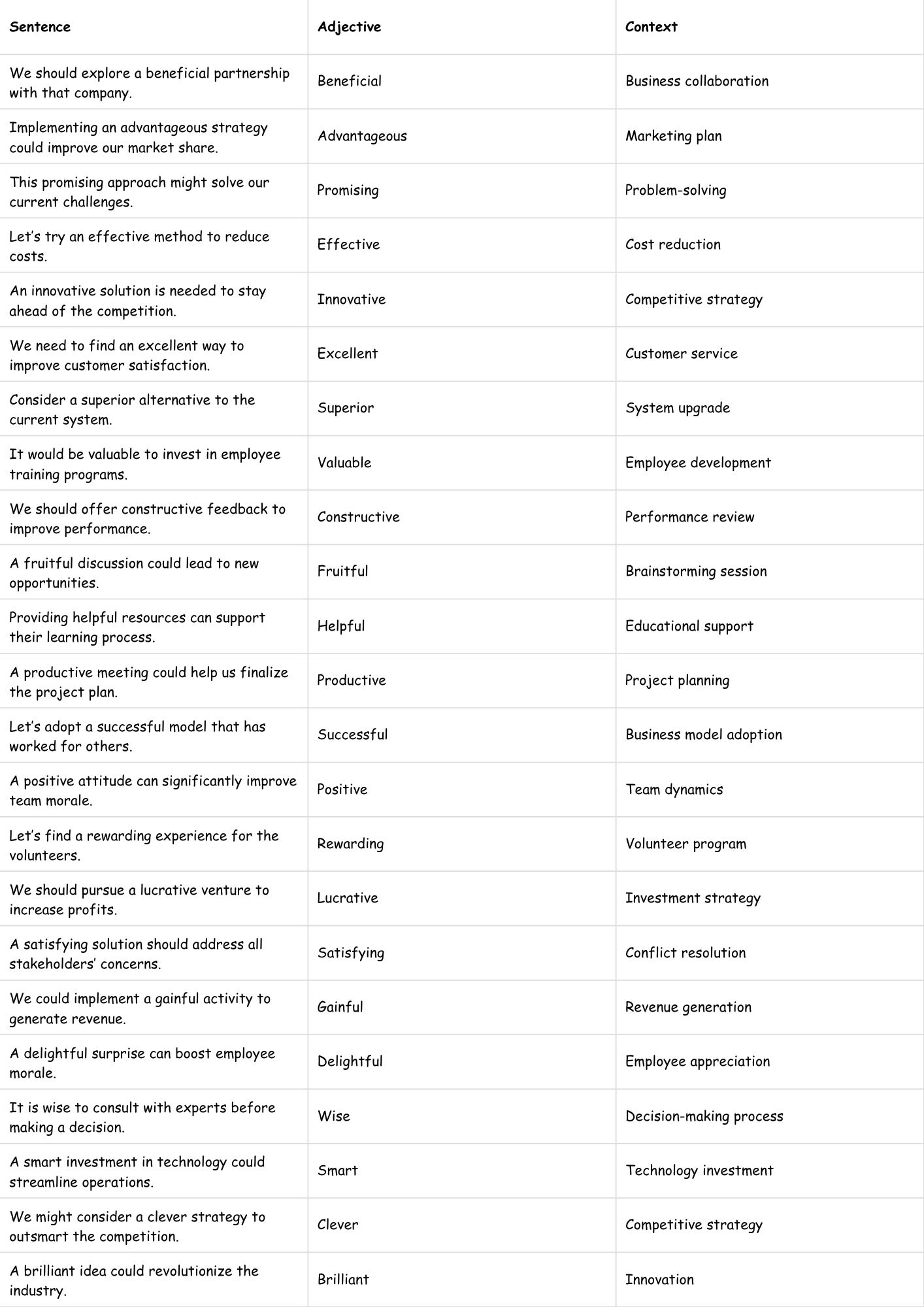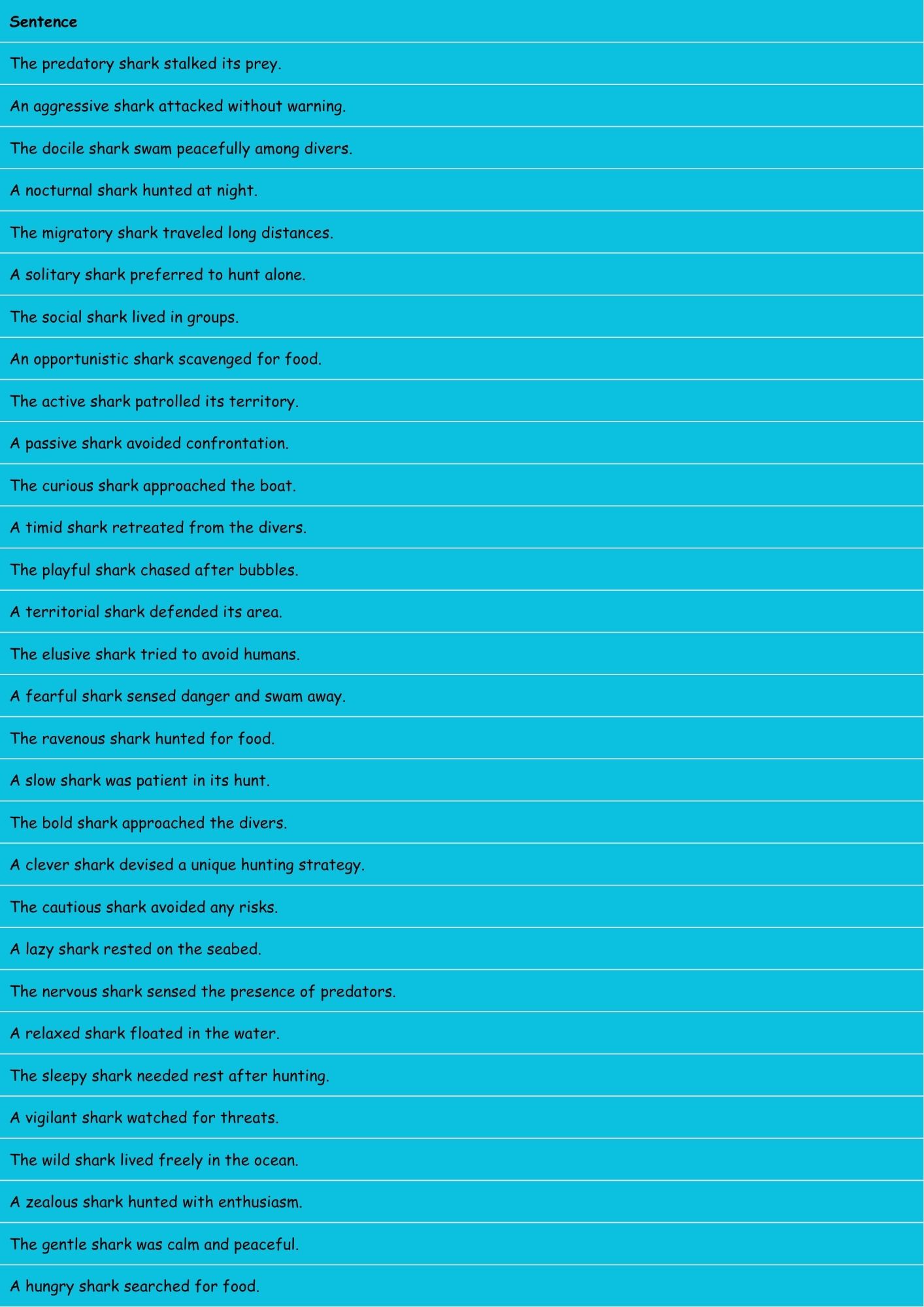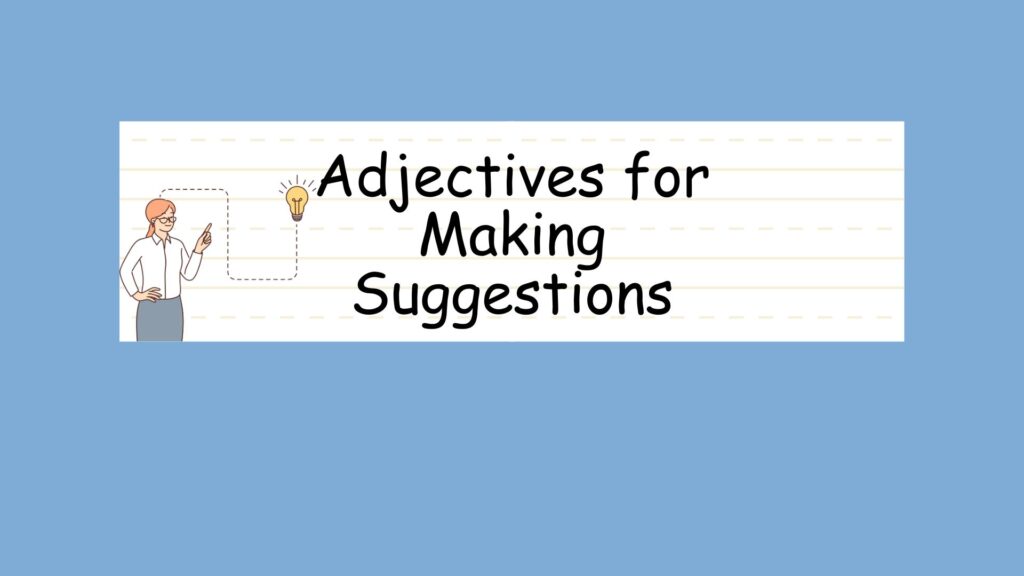Making suggestions is a crucial part of communication, whether you’re planning a weekend getaway, deciding on a project’s direction, or offering advice. Using the right adjectives can significantly enhance the persuasiveness and clarity of your suggestions. This article delves into the world of adjectives that can be used effectively when making suggestions in English. Understanding how to employ these adjectives will not only improve your command of the language but also make your communication more impactful. This guide is designed for English language learners of all levels who want to refine their ability to make compelling and well-received suggestions.
By mastering the use of adjectives for suggestions, you can express your ideas with greater confidence and nuance. This article provides a comprehensive overview, including definitions, structural breakdowns, examples, usage rules, common mistakes, practice exercises, and advanced topics. Whether you are a beginner or an advanced learner, this article will equip you with the tools you need to make suggestions effectively and persuasively.
Table of Contents
- Introduction
- Definition of Adjectives for Suggestions
- Structural Breakdown
- Types and Categories of Adjectives for Suggestions
- Examples of Adjectives for Suggestions
- Usage Rules
- Common Mistakes
- Practice Exercises
- Advanced Topics
- FAQ
- Conclusion
Definition of Adjectives for Suggestions
Adjectives for suggestions are words that describe or modify nouns (things, people, places, or ideas) in a way that implies or enhances a proposed course of action. These adjectives add flavor, nuance, and specificity to the suggestion, making it more compelling or understandable. They help to convey the speaker’s attitude, level of confidence, or the potential benefits of the suggestion. Adjectives used in suggestions can range from positive and encouraging to cautious and tentative, depending on the context and the desired effect.
The primary function of these adjectives is to make the suggestion more persuasive, palatable, or descriptive. They can highlight the advantages, mitigate potential risks, or simply provide a clearer picture of what is being proposed. For instance, instead of saying “We should try this,” one might say “We should try this innovative approach,” where “innovative” adds a positive connotation and implies a potential benefit. Adjectives in suggestions are not limited to describing the action itself; they can also describe the outcome or the circumstances surrounding the suggestion.
These adjectives are often used in various contexts, including business meetings, academic discussions, personal conversations, and even formal presentations. Their effective use can significantly impact how the suggestion is received and whether it is ultimately adopted. Understanding and mastering the use of adjectives for suggestions can greatly enhance one’s communication skills and ability to influence others.
Structural Breakdown
The structure of sentences that include adjectives for suggestions typically follows a basic pattern, but with variations depending on the specific adjective and the context of the suggestion. The most common structure is Subject + Verb + Adjective + Noun, where the adjective modifies the noun that is part of the suggestion.
Here are a few common structural patterns:
- Simple Suggestion: Subject + Verb + Article + Adjective + Noun. Example: “We should consider a practical solution.”
- Using ‘That’ Clause: Subject + Verb + That + Subject + Verb + Adjective + Noun. Example: “I suggest that we implement a comprehensive strategy.”
- Imperative Suggestion: Verb + Article + Adjective + Noun. Example: “Consider a thorough review.”
- Wh- Question Suggestion: Wh- word + auxiliary verb + subject + verb + adjective + noun? Example: “What alternative methods could we explore?”
The adjective usually precedes the noun it modifies. However, in some cases, the adjective can follow a linking verb (such as ‘be,’ ‘seem,’ or ‘appear’) to describe the noun. For example, “This approach seems promising.” In this case, “promising” describes the approach and is linked to it by the verb “seems.”
Understanding these structural patterns is crucial for constructing grammatically correct and effective suggestions. By varying the structure, you can create suggestions that are more persuasive, nuanced, and appropriate for different contexts.
Types and Categories of Adjectives for Suggestions
Adjectives for suggestions can be categorized based on the tone and emphasis they add to the suggestion. These categories include positive, cautious, emphatic, and descriptive adjectives. Each category serves a different purpose and can be used in different contexts to achieve the desired effect.
Positive Adjectives
Positive adjectives highlight the benefits and advantages of a suggestion. They create a sense of optimism and encourage acceptance. Examples include: beneficial, advantageous, promising, effective, innovative, excellent, superior, valuable, constructive, fruitful, and helpful. These adjectives are often used when you want to emphasize the potential positive outcomes of the suggestion.
Cautious Adjectives
Cautious adjectives express a degree of uncertainty or risk associated with the suggestion. They are used to temper expectations and acknowledge potential drawbacks. Examples include: tentative, provisional, experimental, preliminary, possible, potential, speculative, theoretical, hypothetical, and initial. These adjectives are useful when you want to introduce a suggestion without overcommitting to its success.
Emphatic Adjectives
Emphatic adjectives emphasize the importance or urgency of a suggestion. They are used to convey a strong conviction or a sense of necessity. Examples include: essential, crucial, vital, critical, necessary, imperative, urgent, fundamental, significant, and paramount. These adjectives are effective when you want to highlight the critical nature of the suggestion.
Descriptive Adjectives
Descriptive adjectives provide more detail about the suggestion, helping to clarify its nature and scope. They can make the suggestion more understandable and tangible. Examples include: detailed, comprehensive, thorough, systematic, structured, organized, specific, practical, realistic, and logical. These adjectives are useful when you want to provide a clear and well-defined picture of the suggestion.
Examples of Adjectives for Suggestions
The following tables provide extensive examples of how adjectives can be used to enhance suggestions in various contexts. Each table focuses on a different category of adjectives, illustrating their usage with multiple examples.
Positive Adjectives Examples
This table showcases how positive adjectives can make suggestions more appealing and encouraging.
| Sentence | Adjective | Context |
|---|---|---|
| We should explore a beneficial partnership with that company. | Beneficial | Business collaboration |
| Implementing an advantageous strategy could improve our market share. | Advantageous | Marketing plan |
| This promising approach might solve our current challenges. | Promising | Problem-solving |
| Let’s try an effective method to reduce costs. | Effective | Cost reduction |
| An innovative solution is needed to stay ahead of the competition. | Innovative | Competitive strategy |
| We need to find an excellent way to improve customer satisfaction. | Excellent | Customer service |
| Consider a superior alternative to the current system. | Superior | System upgrade |
| It would be valuable to invest in employee training programs. | Valuable | Employee development |
| We should offer constructive feedback to improve performance. | Constructive | Performance review |
| A fruitful discussion could lead to new opportunities. | Fruitful | Brainstorming session |
| Providing helpful resources can support their learning process. | Helpful | Educational support |
| A productive meeting could help us finalize the project plan. | Productive | Project planning |
| Let’s adopt a successful model that has worked for others. | Successful | Business model adoption |
| A positive attitude can significantly improve team morale. | Positive | Team dynamics |
| Let’s find a rewarding experience for the volunteers. | Rewarding | Volunteer program |
| We should pursue a lucrative venture to increase profits. | Lucrative | Investment strategy |
| A satisfying solution should address all stakeholders’ concerns. | Satisfying | Conflict resolution |
| We could implement a gainful activity to generate revenue. | Gainful | Revenue generation |
| A delightful surprise can boost employee morale. | Delightful | Employee appreciation |
| It is wise to consult with experts before making a decision. | Wise | Decision-making process |
| A smart investment in technology could streamline operations. | Smart | Technology investment |
| We might consider a clever strategy to outsmart the competition. | Clever | Competitive strategy |
| A brilliant idea could revolutionize the industry. | Brilliant | Innovation |

Cautious Adjectives Examples
This table demonstrates how cautious adjectives can be used to introduce suggestions with a degree of uncertainty or risk.
| Sentence | Adjective | Context |
|---|---|---|
| We could try a tentative approach to see if it works. | Tentative | Testing a new method |
| A provisional agreement might be a good starting point. | Provisional | Negotiations |
| Let’s conduct an experimental study to gather more data. | Experimental | Research and development |
| A preliminary investigation is needed before making any decisions. | Preliminary | Initial assessment |
| A possible solution might involve restructuring the team. | Possible | Organizational change |
| There is a potential risk associated with this new venture. | Potential | Business venture |
| This is a speculative investment, so proceed with caution. | Speculative | Financial investment |
| The theoretical benefits of this approach need to be validated. | Theoretical | Academic research |
| This is just a hypothetical scenario, but it’s worth considering. | Hypothetical | Scenario planning |
| Our initial assessment suggests that further investigation is needed. | Initial | Assessment report |
| A conditional approval might be considered until all requirements are met. | Conditional | Project approval |
| We could offer a limited warranty on the product. | Limited | Warranty policy |
| A guarded approach might be necessary when dealing with sensitive information. | Guarded | Information management |
| We should take a measured response to the situation. | Measured | Crisis management |
| A cautious approach is advised when entering new markets. | Cautious | Market entry strategy |
| A moderate increase in prices might be acceptable to customers. | Moderate | Pricing strategy |
| We could conduct a pilot program before full implementation. | Pilot | Program launch |
| Let’s take a gradual approach to introducing the changes. | Gradual | Change management |
| We might consider a phased rollout of the new software. | Phased | Software deployment |
| A conservative estimate of the costs should be used for budgeting. | Conservative | Budgeting |
| We can explore a trial period before making a long-term commitment. | Trial | Contract negotiation |
| A careful analysis is needed before proceeding with the project. | Careful | Project planning |
| We should develop a contingency plan to address potential risks. | Contingency | Risk management |
Emphatic Adjectives Examples
This table shows how emphatic adjectives can highlight the importance and urgency of a suggestion.
| Sentence | Adjective | Context |
|---|---|---|
| It is essential to address this issue immediately. | Essential | Problem resolution |
| A crucial step is to secure funding for the project. | Crucial | Project funding |
| Providing vital support to the affected communities is our priority. | Vital | Community support |
| A critical analysis of the data is necessary to draw accurate conclusions. | Critical | Data analysis |
| It is necessary to implement stricter security measures. | Necessary | Security protocols |
| An imperative task is to meet the deadline. | Imperative | Project deadline |
| We need an urgent response to the customer’s complaint. | Urgent | Customer service |
| A fundamental change in strategy is required to achieve our goals. | Fundamental | Strategic planning |
| This is a significant opportunity for growth and expansion. | Significant | Business development |
| Addressing the root cause of the problem is of paramount importance. | Paramount | Problem-solving |
| It’s mandatory to attend the training session. | Mandatory | Employee training |
| A required document must be submitted before the deadline. | Required | Documentation |
| It is compulsory to follow safety regulations. | Compulsory | Safety compliance |
| This is a key element to the success of the project. | Key | Project success |
| A primary concern is the well-being of our employees. | Primary | Employee welfare |
| It is critical to maintain open communication channels. | Critical | Communication strategy |
| A substantial investment is needed to upgrade the infrastructure. | Substantial | Infrastructure upgrade |
| It’s vital to secure intellectual property rights. | Vital | Intellectual property |
| An immediate action is necessary to prevent further damage. | Immediate | Damage control |
| It is imperative to comply with legal requirements. | Imperative | Legal compliance |
| A pressing issue needs to be addressed promptly. | Pressing | Issue resolution |
| It is crucial to have a backup plan in place. | Crucial | Contingency planning |
| A pivotal moment in our decision-making process is now. | Pivotal | Decision making |
Descriptive Adjectives Examples
This table illustrates how descriptive adjectives provide more detail and clarity to suggestions.
| Sentence | Adjective | Context |
|---|---|---|
| Let’s create a detailed plan outlining all the steps involved. | Detailed | Project planning |
| We should conduct a comprehensive review of the existing processes. | Comprehensive | Process improvement |
| A thorough analysis of the market trends is essential. | Thorough | Market research |
| We need to implement a systematic approach to problem-solving. | Systematic | Problem-solving |
| A structured training program will ensure consistency in skills development. | Structured | Training program |
| An organized approach to data management is crucial. | Organized | Data management |
| We need to provide specific instructions to avoid misunderstandings. | Specific | Communication clarity |
| A practical solution should be easy to implement and cost-effective. | Practical | Solution implementation |
| The proposal should be realistic and achievable within the given timeframe. | Realistic | Project proposal |
| A logical argument should be supported by evidence and reasoning. | Logical | Argument presentation |
| Let’s develop a clear communication strategy. | Clear | Communication strategy |
| We should create a concise report summarizing the findings. | Concise | Report writing |
| A precise measurement is needed for accurate results. | Precise | Data collection |
| We need to develop a defined process for handling customer complaints. | Defined | Customer service |
| A well-researched report will provide valuable insights. | Well-researched | Report writing |
| The project requires a collaborative effort from all team members. | Collaborative | Teamwork |
| We should use a standardized procedure to ensure consistency. | Standardized | Process standardization |
| A transparent process will build trust with stakeholders. | Transparent | Stakeholder relations |
| Let’s create a user-friendly interface for the software. | User-friendly | Software design |
| We should establish a secure network to protect sensitive data. | Secure | Network security |
| A robust system will withstand unexpected failures. | Robust | System reliability |
| We need a scalable solution to accommodate future growth. | Scalable | Business growth |
| A sustainable approach will minimize environmental impact. | Sustainable | Environmental impact |

Usage Rules
When using adjectives for suggestions, it is important to follow certain rules to ensure clarity, grammatical correctness, and effective communication. Here are some key usage rules to keep in mind:
- Adjective Placement: Adjectives typically precede the noun they modify. For example, “a practical solution” is correct, while “a solution practical” is incorrect.
- Order of Adjectives: When using multiple adjectives, follow the general order: opinion, size, age, shape, color, origin, material, and purpose. For example, “a beautiful large old round brown Italian wooden table.”
- Linking Verbs: Adjectives can follow linking verbs (such as ‘be,’ ‘seem,’ ‘appear,’ ‘become,’ ‘look,’ ‘sound,’ ‘smell,’ and ‘taste’) to describe the subject. For example, “This idea seems promising.”
- Use of Articles: Use the correct article (‘a,’ ‘an,’ or ‘the’) depending on the adjective and noun. For example, “a useful tool,” “an innovative approach,” and “the best option.”
- Appropriateness: Choose adjectives that are appropriate for the context and audience. Using overly formal or informal adjectives in the wrong setting can be ineffective or even offensive.
- Clarity: Ensure the adjective clearly enhances the suggestion. Avoid using vague or ambiguous adjectives that do not add meaningful information.
- Agreement: Ensure the adjective agrees with the noun in number. Use singular adjectives with singular nouns and plural adjectives with plural nouns. However, most adjectives do not change form to indicate plurality.
By following these usage rules, you can ensure that your suggestions are clear, grammatically correct, and effectively communicated.
Common Mistakes
Even experienced English speakers sometimes make mistakes when using adjectives for suggestions. Here are some common errors and how to avoid them:
| Incorrect | Correct | Explanation |
|---|---|---|
| We should try solution practical. | We should try a practical solution. | Adjectives usually precede the noun. |
| This idea is seeming promising. | This idea seems promising. | Use the correct form of the linking verb. |
| An useful tool is needed. | A useful tool is needed. | Use “a” before consonant sounds and “an” before vowel sounds. |
| The most importantest thing is to focus. | The most important thing is to focus. | Avoid double superlatives. |
| Let’s use more efficient way. | Let’s use a more efficient way. | Include the article “a” or “an” when necessary. |
| This approach is more better. | This approach is better. | Avoid double comparatives. |
| A detail plan is needed. | A detailed plan is needed. | Use the correct form of the adjective. |
| We need a very much detailed report. | We need a very detailed report. | Avoid unnecessary words. |
| The issue needs an urgent addressing. | The issue needs urgent addressing. | Adjectives should directly modify the related noun. |
| It is a necessarily step. | It is a necessary step. | Use the correct form of the adjective. |
By being aware of these common mistakes and practicing correct usage, you can improve your accuracy and fluency when using adjectives for suggestions.
Practice Exercises
These exercises will help you practice using adjectives for suggestions correctly. Each exercise focuses on a different aspect of adjective usage, from filling in the blanks to correcting errors.
Exercise 1: Fill in the Blanks
Choose the most appropriate adjective from the list below to fill in the blank in each sentence.
(beneficial, cautious, essential, thorough, innovative, practical, tentative, crucial, detailed, effective)
| Question | Answer |
|---|---|
| 1. A ________ review of the data is needed before making a decision. | thorough |
| 2. It is ________ to address the customer’s concerns immediately. | essential |
| 3. We should explore a ________ partnership with that organization. | beneficial |
| 4. Let’s try a ________ approach to see if it works. | tentative |
| 5. Implementing an ________ strategy could improve our market position. | effective |
| 6. A ________ step is to secure funding for the project. | crucial |
| 7. We need a ________ plan outlining all the steps involved. | detailed |
| 8. An ________ solution is needed to stay ahead of the competition. | innovative |
| 9. A ________ solution should be easy to implement and cost-effective. | practical |
| 10. We should adopt a ________ approach when entering new markets. | cautious |
Exercise 2: Sentence Transformation
Rewrite each sentence using a more descriptive adjective to enhance the suggestion.
| Question | Answer |
|---|---|
| 1. We should try this method. | We should try this innovative method. |
| 2. Let’s have a meeting to discuss the issue. | Let’s have a productive meeting to discuss the issue. |
| 3. We need to address this problem. | We need to address this urgent problem. |
| 4. We should review the documents. | We should review the comprehensive documents. |
| 5. This is an important task. | This is a crucial task. |
| 6. We need to make a change to the process. | We need to make a fundamental change to the process. |
| 7. Let’s consider this option. | Let’s consider this promising option. |
| 8. We should provide training to the employees. | We should provide essential training to the employees. |
| 9. We need to find a solution. | We need to find a practical solution. |
| 10. We should analyze the data. | We should analyze the thorough data. |
Exercise 3: Error Correction
Identify and correct the errors in the following sentences.
| Question | Answer |
|---|---|
| 1. We should try solution innovative. | We should try an innovative solution. |
| 2. The most importantest thing is to act now. | The most important thing is to act now. |
| 3. Let’s use more efficient way possible. | Let’s use the most efficient way possible. |
| 4. This approach is more better than the old one. | This approach is better than the old one. |
| 5. A detail plan needs to be created. | A detailed plan needs to be created. |
| 6. The issue needs an urgent addressing. | The issue needs urgent addressing. |
| 7. It is a necessarily step to take. | It is a necessary step to take. |
| 8. An useful strategy could help us. | A useful strategy could help us. |
| 9. We must implement safety better measures. | We must implement better safety measures. |
| 10. A careful analyze is required. | A careful analysis is required. |
Advanced Topics
For advanced learners, understanding the nuances of using adjectives for suggestions can involve exploring more complex aspects such as:
- Subtle Connotations: Recognizing the subtle differences in meaning between similar adjectives. For example, understanding the difference between “effective” and “efficient.”
- Figurative Language: Using adjectives metaphorically to create more vivid and impactful suggestions. For example, “Let’s build a robust shield against future risks.”
- Cultural Sensitivity: Being aware of how certain adjectives might be perceived differently in different cultures. For example, adjectives that imply directness might be considered rude in some cultures.
- Rhetorical Devices: Employing adjectives strategically to persuade and influence the audience. For example, using a series of positive adjectives to create a sense of momentum and enthusiasm.
- Adjective Clauses: Using adjective clauses to provide more detailed and nuanced descriptions of the suggestions. For example, “We should consider the option that offers the most sustainable solution.”
By delving into these advanced topics, you can further refine your ability to use adjectives for suggestions in a sophisticated and effective manner.
FAQ
Here are some frequently asked questions about using adjectives for suggestions:
- What is the best way to choose the right adjective for a suggestion?Consider the context, your audience, and the tone you want to convey. Positive adjectives are great for building enthusiasm, while cautious adjectives are useful for tempering expectations. Descriptive adjectives are helpful for providing clarity and detail. Always choose an adjective that accurately reflects the nature and potential impact of the suggestion.
- Can I use multiple adjectives in a single suggestion?Yes, but use them sparingly. Too many adjectives can make the suggestion sound cluttered and confusing. When using multiple adjectives, follow the general order of adjectives (opinion, size, age, shape, color, origin, material, purpose) and ensure they all contribute meaningfully to the suggestion.
- How do I avoid using vague or ambiguous adjectives?Choose adjectives that have a clear and specific meaning. Avoid using adjectives that are overly general or subjective. For example, instead of saying “a good idea,” say “a practical idea” or “an innovative idea.” The more specific the adjective, the more impactful the suggestion will be.
- Are there any adjectives I should avoid when making suggestions?Avoid using adjectives that are negative, dismissive, or overly critical. These can create a hostile or defensive environment and undermine the suggestion. Also, avoid using adjectives that are culturally insensitive or offensive. Always strive to use adjectives that are respectful, constructive, and appropriate for the context.
Conclusion
Mastering the use of adjectives for suggestions is a valuable skill for anyone looking to improve their communication and influence. By understanding the different types of adjectives, following usage rules, avoiding common mistakes, and practicing regularly, you can significantly enhance the persuasiveness and clarity of your suggestions. Whether you are making suggestions in a professional, academic, or personal setting, the effective use of adjectives can help you express your ideas with greater confidence and impact.
Continue to practice and refine your understanding of adjectives for suggestions, and you will find that your ability to communicate effectively and persuasively will greatly improve. Remember to consider the context, audience, and desired tone when choosing your adjectives, and always strive to use language that is clear, respectful, and impactful.



